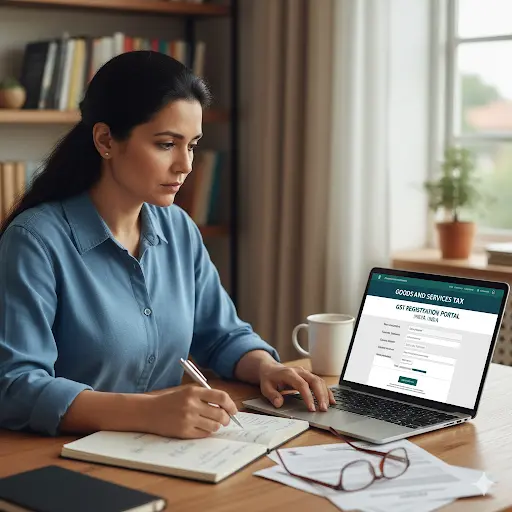GST Registration 2025 Guide: Eligibility, Documents, Steps & Fixes
Getting GST Registration 2025 right is more than ticking boxes—it prevents routine notices, keeps e-way bills and refunds on track, and enhance trust signals that you run a compliant business. This layman-friendly guide starts with clear numbers on who needs a GSTIN: ₹20 lakh for most States/UTs, ₹10 lakh for Manipur, Mizoram, Nagaland, Tripura, and—where adopted—₹40 lakh for goods-only suppliers. We also explain when Section 24 forces registration even below the threshold, and the carve-out that lets small inter-State service providers stay outside GST until they cross ₹20/₹10 lakh.
Next, you’ll see the portal flow (REG-01 → REG-06), the documents officers actually look for, and what Aadhaar/biometric or physical verification means in practice. If you get a REG-03 clarification, use our reply SOP; if things go wrong, follow the steps for cancellation, suspension and revocation with the right forms and rules. Every claim links to official sources so you can verify it yourself.
Quick Summary— Do I need a GST Registration (GSTIN) today?
- Most States/UTs: Register once aggregate turnover > ₹20,00,000.
- Manipur, Mizoram, Nagaland, Tripura: Threshold ₹10,00,000.
- Goods-only traders: In States that adopted the option, limit is ₹40,00,000; otherwise ₹20,00,000.
- Compulsory (Section 24): Register regardless of turnover if you fall in compulsory buckets (e.g., RCM liability, NRTP, e-commerce operator, TDS/TCS, ISD, certain inter-State supplies).
- Important carve-out: Small inter-State services are exempt up to ₹20L/₹10L (IGST 10/2017).
- No registration: Only exempt/non-taxable supplies, or agriculturist selling own produce.
(See Section 1 for sources and examples.)
Who actually needs a GST Registration (GSTIN) and who doesn’t
Thresholds at a glance
- ₹20 lakh: Base threshold for most States/UTs (for goods or services). If your PAN-level aggregate turnover (all-India) in the year exceeds ₹20 lakh, you become liable to register. (Source: Sec 22 of CGST)
- ₹10 lakh: Only in Manipur, Mizoram, Nagaland, Tripura. These are the remaining “special category States” for registration thresholds under the Explanation to Section 22.
- ₹40 lakh (goods-only, optional): Many States have opted to raise the limit for exclusive suppliers of goods to ₹40 lakh via Notification 10/2019-Central Tax (this never overrides compulsory cases under Section 24). If your State hasn’t opted, the default remains ₹20 lakh. (Source: n/no. 10/2019-Central Tax ,dt. 07-03-2019)
Check – (1) what you supply—goods vs services, (2) where you supply from (State), and (3) if any compulsory category applies to you (below).
The three core sections of law in simple terms
- Section 22 (who must register): If your PAN-level turnover crosses the threshold (₹20/10 lakh; or ₹40 lakh for eligible goods-only States), you must obtain the GST registration in every State/UT from where you make supplies.
- Section 24 (compulsory registration, overrides thresholds): You must register even below threshold if you fall into certain buckets (e.g., inter-State taxable supply, reverse charge, casual/non-resident taxable person, TDS/TCS, ISD, e-commerce operators).
- Section 23 (who need not register): If you exclusively make wholly exempt or non-taxable supplies, or you are an agriculturist selling your own produce, you’re not liable to register.
Important carve-out for small inter-State service providers
Originally, inter-State supply meant compulsory registration. But IGST Notification 10/2017 exempts persons making inter-State supplies of taxable services from GST registration if their aggregate turnover does not exceed ₹20 lakh (₹10 lakh in the 4 special States)—so small inter-State service providers need not register solely for crossing a state border.
Quick examples
- Freelance designer (Delhi) billing Mumbai clients, ₹7 lakh/year: No GST registration solely on inter-State service grounds because of IGST 10/2017; reassess if you cross ₹20 lakh or fall under any Section 24 bucket.
- Goods-only trader, ₹32 lakh, in a State that adopted the ₹40 lakh limit: May stay unregistered (watch Section 24 compulsory cases). If your State didn’t adopt the ₹40 lakh option, you’re back to ₹20 lakh.
- Farmer selling own produce: No registration (Section 23).
Documents checklist for GSt registration (and why officers ask for each)
Think of documents as three proofs officers look for:
- Who you are (KYC/constitution) — PAN, photographs; partnership deed/LLP agreement/Certificate of Incorporation (+ MOA/AOA if applicable).
- Where you do business (place of business) — ownership proof or registered rent/lease + recent utility bill; if using a residence, add a simple owner NOC.
- Your bank trail — cancelled cheque with pre-printed name, first page of passbook or bank letter.
Your application is FORM GST REG-01: Part-A (basic details to generate TRN) and Part-B (business, principal & other places, bank, HSN/SAC, authorised signatory, uploads). Officers are expected to stick to what REG-01 requires and avoid unnecessary extras.
Practical tips
- Keep scan names clear (e.g., RentDeed_2025-01-10.pdf), and ensure trade name matches across bank proof, deed, and application.
- Add all additional places now (warehouses/branches) to avoid early amendments.

Aadhaar e-KYC, biometric & physical verification (what really happens)
- Most applicants complete OTP-based Aadhaar e-KYC during REG-01 (Rule 8 step). If risk flags appear, you may be called for biometric authentication and document check at a facilitation centre.
- If Aadhaar is not authenticated/fails, the officer may order physical verification. Rule 25 requires uploading a REG-30 report with photos—within 15 working days after verification (and special timelines before grant if verification is pre-approval).
- Separate from initial registration, Rule 10B requires Aadhaar authentication for registered persons to be eligible for certain actions (e.g., refunds, revocation of cancellation).
Make verification easy
- Keep a visible signboard, basic books/stock, and an authorised person on site.
- Ensure the premises match your uploads (photos, layout, activity).
Step-by-step: Apply on the GST portal (REG-01 → REG-06)
Start: Open the GST portal’s official user guide and follow the below step in practice.
The Step in practice
- Part-A: Enter PAN, mobile, email → get TRN.
- Part-B: Fill business details, add principal & other places, choose HSN/SAC, add authorised signatory, upload documents.
- Aadhaar e-KYC/biometric (Rule 8).
- Officer verification & timelines — Rule 9 says if your papers are in order, approval should come within 7 working days. If the officer needs more info, you’ll get REG-03; reply point-wise via REG-04 within the time allowed.
- Approval — download REG-06 certificate from your GST portal dashboard (post-approval).
Pre-submit checklist
- HSN/SAC mapped? All additional places added? Bank proof name matches business name? Files readable and under size limit?
Timelines, clarifications & common rejections (and how to avoid them)
If your GST registration application is complete in all respect along with requisite documents, officer should approve in 7 working days (Rule 9). If you get REG-03, respond with REG-04 on time; non-response or weak replies can result in REG-05 (rejection). Physical verification extends timelines.
REG-03 reply SOP
- Use a cover note mirroring each point in the notice → your explanation → file name.
- Label proofs clearly (e.g., REG03_Point1_Address.pdf).
- Attach fresh, legible scans; submit before the portal due date.
Most frequent pitfalls
- Address proof not in entity name or old/unsigned rent deed/NOC.
- Bank proof without pre-printed name.
- Aadhaar not authenticated → triggers biometric/physical verification.
- Photos that don’t match declared activity (e.g., no stock for a trader).
- Vague activity/HSN descriptions.
After approval: early housekeeping that prevents headaches
Rule 10A requires you to furnish bank account details within 30 days of gst registration or before the first GSTR-1/IFF, whichever is earlier—do this immediately.
Your first-week to-do list
- Update bank details on portal (Services → Registration → Amendment). (Rule 10A)
- Set invoice series and HSN reporting levels; enable e-Invoice/e-Way Bill if applicable (as per portal modules).
- Add users and additional places if missed during REG-01.
Heads-up on suspension: Failing to update bank details (or certain risk mismatches) can lead to suspension under Rule 21A until you fix it.
Cancellation, suspension & revocation — with a real-life example
If you receive REG-17 (show-cause for cancellation), reply in REG-18 with evidence: latest returns, challans, premises photos, utility bills, lease/ownership documents, sample invoices/delivery challans. Rule 22 governs this process.
- If your gst registration is cancelled, you can seek revocation under Section 30 read with Rule 23 by filing REG-21 within time (extensions are possible under Section 30). Aadhaar (Rule 10B) is a pre-condition.
- Suspension during proceedings is covered by Rule 21A.
Here is the quick summary of law in practice
- Section 29: When GSTINs can be cancelled (e.g., non-filing, bogus particulars, not found at place).
- Rule 21A: Suspension during proceedings; often blocks GSTR-1/e-Way Bill.
- Rule 22: Procedure — REG-17 (SCN) → REG-18 (your reply) → REG-19 (cancellation) or REG-20 (dropping).
- Section 30 + Rule 23: Revocation via REG-21 after clearing returns/dues; Aadhaar (Rule 10B) applies. Officer may issue REG-23 (query) → REG-22 (revocation) or REG-24 (rejection).
Real-life worked example (revocation) — ABC Foods Pvt. Ltd., Delhi
- Problem: Missed GSTR-3B for Oct–Dec → Rule 21A suspension on 04 Jan; REG-17 on 05 Jan; REG-19 cancellation on 20 Jan (no REG-18 reply).
- Fix: 21–24 Jan file GSTR-3B + interest/late fees and GSTR-1; 24–25 Jan complete Aadhaar (Rule 10B); add electricity bill, rent, premises photos.
- 27 Jan: File REG-21 with a short cover note (cause, compliance done, controls added).
- 29–31 Jan: REG-23 query (why non-filing, stock?). ABC replies point-wise with stock extracts, bank highlights, return acks; attends a brief hearing.
- 05 Feb: REG-22 revokes cancellation; e-Way Bill unblocked; billing resumes.
Files ABC attached (you should too):
Returns & payments (GSTR-3B acks, PMT-06 challans), GSTR-1 acks, Aadhaar auth (Rule 10B), latest utility bill, rent/ownership, photos (inside+outside signboard), and a 1-page controls note.
Aadhaar or site visit flagged? What “physical verification” really means
If Aadhaar authentication fails/is not opted, or if there are risk flags, the officer can order physical verification before or after grant of registration. Rule 25 requires a REG-30 report with photos to be uploaded within 15 working days (or within special timelines if verification is pre-approval). Your presence (or an authorised person’s) is expected. Keep signage, books, and stock ready.
Appeals (Section 107) & where GSTAT fits (Section 109)
When you disagree with a registration order (e.g., rejection, cancellation, revocation refused):
A. First appeal — Section 107 | Rule 108 (APL-01)
- What it is: Appeal to the Appellate Authority against the order of the proper officer.
- How to file: On the GST portal in Form APL-01 (Rule 108 procedure). Attach the impugned order, grounds, and evidence.
- When: File within the prescribed time counted from the date of communication of the order (check the portal deadline shown in the order/ack).
- What to include:
- A concise statement of facts and grounds (numbered).
- Copies of your REG-01/REG-18/REG-21 and all annexures relied upon.
- Proofs of compliance (returns paid/ filed, Aadhaar 10B status, premises evidence).
- Outcome: Appellate Authority may confirm, modify, or annul the order; it can remand for fresh decision.
B. Next level — Section 109 (GSTAT)
- What it is: Appeal to the GST Appellate Tribunal against orders of the Appellate Authority, when benches are functional.
- Scope note: Registration disputes sit within the GST appellate chain (they do not go to CESTAT or Income-tax CIT(A)).
Practical appeal tips
- Keep your grounds tight: jurisdiction, natural justice (no hearing/non-speaking order), evidence ignored, law misapplied.
- Add a one-page timeline (events, forms, dates).
- Attach clean PDFs and paginate; use index & bookmarks for larger bundles.
- If the order is cryptic, cite the Allahabad HC line (see Case Law C) on reasoned orders.
- If you regularized compliance after lapse, cite the Suguna Cutpiece line (Case Law B) for restoration subject to conditions.
Important court decisions
A) Supreme Court — Radha Krishan Industries v. State of Himachal Pradesh (2021)
- What happened: Bank accounts were provisionally attached under Section 83; the assessee moved a writ.
- Key issue: Can High Courts entertain writs despite alternate remedies, and was the attachment proper?
- Decision (why it helps): The Court spelt out when writs are maintainable (e.g., lack of jurisdiction, violation of natural justice) and found the attachment unsustainable on facts. This supports challenges where procedure/natural justice is compromised.
B) Madras High Court — Tvl. Suguna Cutpiece Center line (2022, batch matters)
- What happened: Large batch of taxpayers faced cancellation (often due to non-filing/portal issues); many later regularised returns and paid dues.
- Key issue: Can revocation/restoration be allowed even if the statutory window lapsed, once compliance is regularised?
- Decision (why it helps): The Court issued directions facilitating restoration/revocation subject to conditions, discouraging hyper-technical denial when revenue loss is cured. Cite this when you’ve fixed compliance and seek a fair revocation.
C) Allahabad High Court — cryptic (non-speaking) cancellation orders set aside
- What happened: GSTINs were cancelled using template-like orders without addressing the taxpayer’s reply.
- Key issue: Must authorities pass reasoned orders after considering replies/evidence?
- Decision (why it helps): Courts quashed such orders and directed fresh, reasoned decisions—useful if your order ignores your documents/defence.
Conclusion
Based on the above, it is advisable that Map your facts to Sec. 22/23/24; complete REG-01 with clean scans; finish Aadhaar e-KYC; and reply to REG-03 quickly. After approval, update bank (Rule 10A), set invoice series/HSN, and enable e-Invoice/e-Way if needed. If cancelled, use sec.30/rule.23 with Rule 10B Aadhaar; rely on Suguna Cut piece when compliance is regularized and orders are hyper-technical, and on the Allahabad HC line if your order is non-speaking.
FAQ on GST registration guide
1) What is the general GST registration limit in India?
₹20 lakh for most States/UTs; ₹10 lakh in Manipur, Mizoram, Nagaland, Tripura. For goods-only suppliers, some States have adopted ₹40 lakh—but Section 24 compulsory categories still override. (See Sections 22, 24; Notif. 10/2019-CT.)
2) I’m a small service provider billing clients in another State—do I need to register?
Not if your aggregate turnover is ≤ ₹20 lakh (or ₹10 lakh in the four special States). IGST Notif. 10/2017 relaxes “inter-State services = compulsory registration” for small providers. (Check your current turnover.)
3) Who does not need a GSTIN at all?
Those exclusively supplying wholly exempt or non-taxable goods/services, and agriculturists selling their own produce. Start registration once you begin any taxable supply. (Section 23.)
4) Can I register voluntarily below the threshold?
Yes. You can register voluntarily to claim ITC or sell to larger clients—but full compliance (returns, e-invoicing where applicable, etc.) applies from day one. (Section 25(3).)
5) What documents do I need for REG-01—and why?
Three proofs: identity/constitution (PAN, COI/deed), place of business (ownership or rent/lease + recent utility; NOC if residential), and bank trail (cancelled cheque with pre-printed name/passbook/bank letter). Officers are told to stick to REG-01. (See portal user guide + REG-01.)
6) How long does approval take?
If complete, about 7 working days. If the officer needs more info, you’ll receive REG-03—reply point-wise via REG-04 within time. Physical verification extends timelines. (Rule 9.)
7) What if Aadhaar e-KYC fails or I’m routed to biometric/physical verification?
You may need biometric + document check at a facilitation centre or physical verification of premises with a REG-30 report and photos. Keep signboard, books/stock, authorised person ready. (Rules 8, 25.)
8) What should a good REG-03 reply look like?
A one-page cover note listing each point → your answer → file name, plus clear, recent scans named like REG03_Point1_AddressProof.pdf. Submit before the due date; keep the ARN/ack. (Rule 9.)
9) I got my GSTIN—what should I do immediately?
Update bank details (Rule 10A) within 30 days or before first GSTR-1/IFF (whichever is earlier). Set invoice series & HSN levels; enable e-Invoice/e-Way Bill if applicable; add users/places; update website/invoices with GSTIN. (Rule 10A.)
10) My registration got cancelled—can I get it back?
Usually yes. File pending returns, pay dues, complete Aadhaar (Rule 10B), then file REG-21 for revocation within time (extensions possible). Courts have also allowed restoration where compliance is regularised and orders were non-speaking. (Section 30; Rule 23; key HCs.)
11) Where do I appeal a refusal or revocation denial?
First to the Appellate Authority under Section 107 (as per Rule 108/APL-01). Next level is GSTAT under Section 109 when benches are functional. (Not CESTAT/CIT(A).)
12) Do I need separate registrations for multiple States or business verticals?
Yes for each State/UT from where you make supplies. Separate registration for distinct business verticals is possible if Section 25(2) criteria fit, but weigh the extra compliance.
13) What are the most common reasons for rejection?
Address proof mismatch; old/unsigned rent deed/NOC; bank proof without pre-printed name; Aadhaar not authenticated; premises photos inconsistent with activity; vague HSN/activity description.
14) Is the ₹40 lakh limit available for services?
No. The ₹40 lakh option is for eligible goods-only suppliers in States that adopted it. Services remain at ₹20/₹10 lakh (unless you hit Section 24 compulsory categories).
15) What exactly is “aggregate turnover”?
Your PAN-level, all-India turnover: taxable + exempt + exports (CGST/SGST/IGST/cess excluded). Use this to test thresholds and composition/e-invoice triggers.
Disclaimer
This article is general guidance. GST law evolves via notifications, circulars and court rulings. Always verify with the bare provisions and official notifications linked above and apply them to your facts (State-wise adoption of the ₹40 lakh goods-only option varies). For litigation, consult a professional and review the latest departmental instructions and judgments.
Further reading
GST Registration Checklist 2025-Free Download



